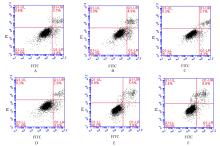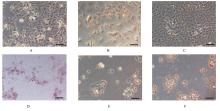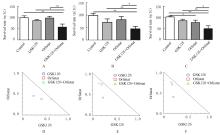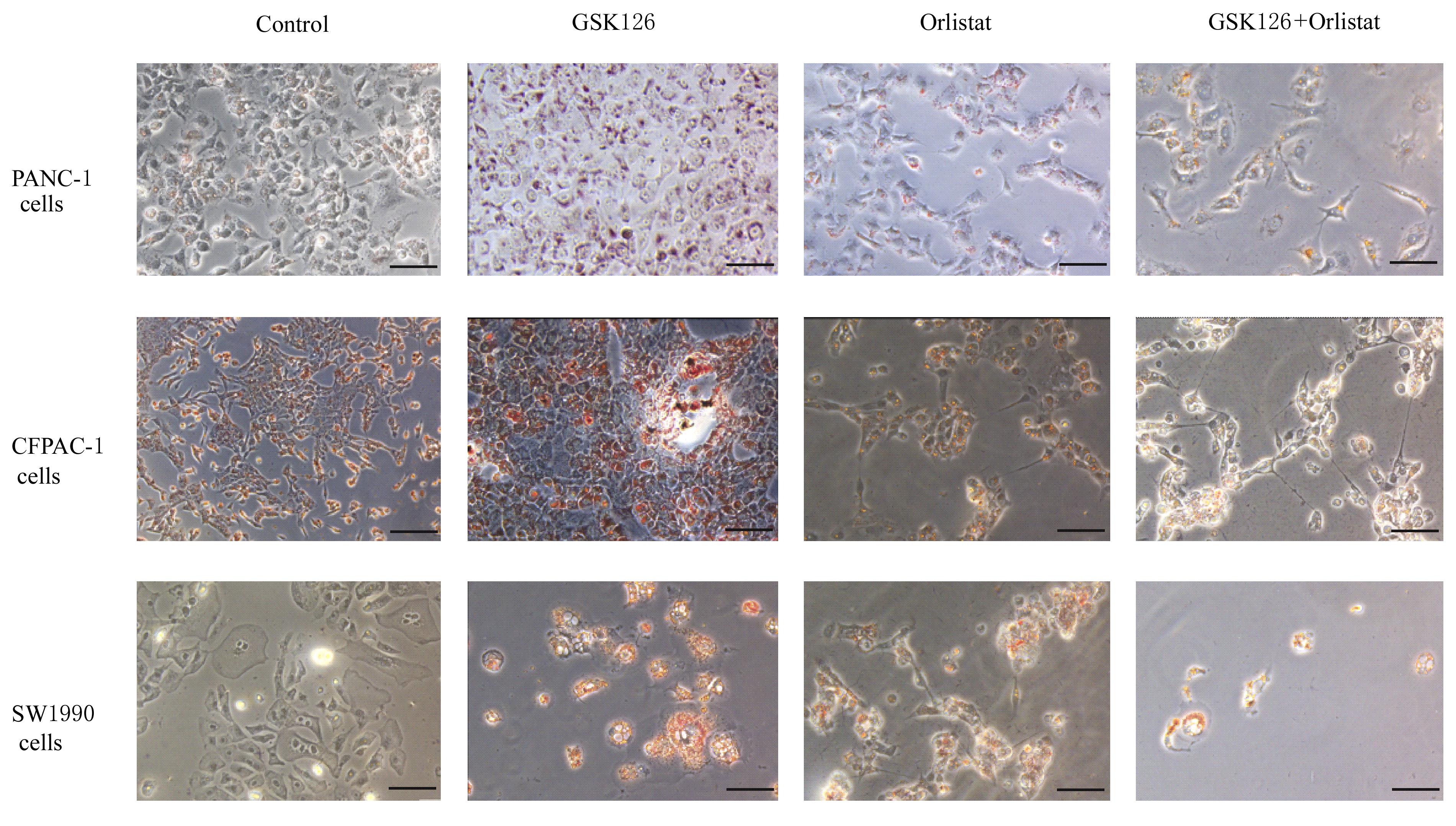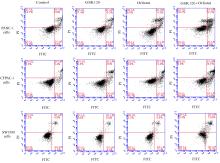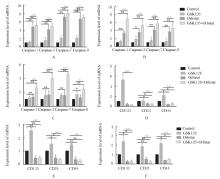Journal of Jilin University(Medicine Edition) ›› 2023, Vol. 49 ›› Issue (1): 55-66.doi: 10.13481/j.1671-587X.20230108
• Research in basic medicine • Previous Articles Next Articles
Effect of Orlistat combined with EZH2 inhibitor GSK126 on lipid metabolism reprogramming in pancreatic cancer cells
Xiaohui WU1,Fan YANG1,Xinru GUO1,Ke YUAN1,Zongyi MA1,Ting LIAN1,Rajiv Kumar JHA2( )
)
- 1.School of Clinical Medicine,Xi’an Medical University,Xi’an 710021,China
2.China-Nepal Friendship Medical Research Center of Prof. Rajiv Kumar JHA,Xi’an Medical University,Xi’an 710021,China
-
Received:2022-03-11Online:2023-01-28Published:2023-02-03 -
Contact:Rajiv Kumar JHA E-mail:rajiv12@hotmail.com
CLC Number:
- R735.9
Cite this article
Xiaohui WU,Fan YANG,Xinru GUO,Ke YUAN,Zongyi MA,Ting LIAN,Rajiv Kumar JHA. Effect of Orlistat combined with EZH2 inhibitor GSK126 on lipid metabolism reprogramming in pancreatic cancer cells[J].Journal of Jilin University(Medicine Edition), 2023, 49(1): 55-66.
share this article
Tab.1
Primer sequences of RT-qPCR"
| Gene | Forward (5'—3') | Reverse (5'—3') |
|---|---|---|
| Caspase-1 | GCCTGTTCCTGTGATGTGGAG | TGCCCACAGACATTCATACAGTTTC |
| Caspase-3 | GACTCTGGAATATCCCTGGACAACA | AGGTTTGCTGCATCGACATCTG |
| Caspase-7 | ATGTCACCATGCGATCCATCA | TCCGTTTCGAACGCCCATA |
| Caspase-9 | CTTGAGACACTCGCTCAGCTTC | CTTGAGACACTCGCTCAGCTTC |
| CD133 | AGTGGCATCGTGCAAACCTG | CTCCGAATCCATTCGACGATA |
| CD24 | CTCCTACCCACGCAGATTTATT | GTGGTGGCATTAGTTGGATTTG |
| CD44 | GAAATGGCACCACTGCTTATG | CTACTAGGAGTTGCCTGGATTG |
| VEGFA | AGGGCAGAATCATCACGAAGT | AGGG TCTCGATTGGATGGCA |
| E-cadherin | ATCAAAGGTATCACGGCAAACG | CGGAGAGCTCGTCCACGTAT |
| FASN | CTAGGTTTGATGCCTCCTTCTT | GATGGCTTCATAGGTGACTTCC |
| ACACA | CTTGCTAGGGCAGAAGGTATTC | CCCAGGCCACATGAAACATA |
| CS | GAGCAGGGTAAAGCCAAGAA | CCAAACAGGACCGTGTAGTAAT |
| ACLY | GTCTCATCGGAGTCGCATTT | CTCCTTCCCAGCACAAAGAT |
| SCD | GCACATCAACTTCACCACATTC | GTAGTTTCCATCTCCGGTTCTT |
| ACSS2 | ACGCTTTGAGACAACCTACTT | CCTGCCAGTGATCCAGTAATAG |
| β-actin | ATTGCCGACAGGATGCAGA | GAGTACTTGCGC TCAGGAGGA |
| 1 | ZENG S Y, PÖTTLER M, LAN B, et al. Chemoresistance in pancreatic cancer[J]. Int J Mol Sci, 2019, 20(18): 4504. |
| 2 | SUNG H, FERLAY J, SIEGEL R L, et al. Global cancer statistics 2020: GLOBOCAN estimates of incidence and mortality worldwide for 36 cancers in 185 countries[J].CA Cancer J Clin,2021,71(3):209-249. |
| 3 | SUNAMI Y, BÖKER V, KLEEFF J. Targeting and reprograming cancer-associated fibroblasts and the tumor microenvironment in pancreatic cancer[J]. Cancers, 2021, 13(4): 697. |
| 4 | GARDNER K P, TSAI S, ALDAKKAK M, et al. CXCR4 expression in tumor associated cells in blood is prognostic for progression and survival in pancreatic cancer[J]. PLoS One, 2022, 17(3): e0264763. |
| 5 | OUGOLKOV A V, BILIM V N, BILLADEAU D D. Regulation of pancreatic tumor cell proliferation and chemoresistance by the histone methyltransferase enhancer of zeste homologue 2[J]. Clin Cancer Res, 2008, 14(21): 6790-6796. |
| 6 | HAN T, JIAO F, HU H, et al. EZH2 promotes cell migration and invasion but not alters cell proliferation by suppressing E-cadherin, partly through association with MALAT-1 in pancreatic cancer[J]. Oncotarget, 2016, 7(10): 11194-11207. |
| 7 | JIN X, YANG C, FAN P, et al. CDK5/FBW7-dependent ubiquitination and degradation of EZH2 inhibits pancreatic cancer cell migration and invasion[J]. J Biol Chem, 2017, 292(15): 6269-6280. |
| 8 |
KURMASHEVA R T, SAMMONS M, FAVOURS E,et al. Initial testing (stage 1) of tazemetostat (EPZ-6438), a novel EZH2 inhibitor, by the Pediatric Preclinical Testing Program[J]. Pediatr Blood Cancer, 2017, 64(3).DOI: 10.1002/pbc.26218 .
doi: 10.1002/pbc.26218 |
| 9 | LEE W, TECKIE S, WIESNER T, et al. PRC2 is recurrently inactivated through EED or SUZ12 loss in malignant peripheral nerve sheath tumors[J]. Nat Genet, 2014, 46(11): 1227-1232. |
| 10 | DUAN R, DU W F, GUO W J. EZH2: a novel target for cancer treatment[J].J Hematol Oncol,2020,13(1): 104. |
| 11 | XU H, ZHANG L S, QIAN X H, et al. GSK343 induces autophagy and downregulates the AKT/mTOR signaling pathway in pancreatic cancer cells[J]. Exp Ther Med, 2019, 18(4): 2608-2616. |
| 12 | HUANG X, YAN J, ZHANG M, et al. Targeting epigenetic crosstalk as a therapeutic strategy for EZH2-aberrant solid tumors[J]. Cell, 2018, 175(1): 186-199. |
| 13 | CHOU T C. Theoretical basis, experimental design, and computerized simulation of synergism and antagonism in drug combination studies[J]. Pharmacol Rev, 2006, 58(3): 621-681. |
| 14 | WANG Y Y, WANG M, WEI W J, et al. Disruption of the EZH2/miRNA/β-catenin signaling suppresses aerobic glycolysis in glioma[J]. Oncotarget, 2016, 7(31): 49450-49458. |
| 15 | AVAN A, CREA F, PAOLICCHI E, et al. Molecular mechanisms involved in the synergistic interaction of the EZH2 inhibitor 3-deazaneplanocin A with gemcitabine in pancreatic cancer cells[J]. Mol Cancer Ther, 2012, 11(8): 1735-1746. |
| 16 | SUBRAMANIAM D, RAMALINGAM S, HOUCHEN C W, et al. Cancer stem cells: a novel paradigm for cancer prevention and treatment[J]. Mini Rev Med Chem, 2010, 10(5): 359-371. |
| 17 | SWIERCZYNSKI J, HEBANOWSKA A, SLEDZINSKI T. Role of abnormal lipid metabolism in development, progression, diagnosis and therapy of pancreatic cancer[J]. World J Gastroenterol, 2014, 20(9): 2279-2303. |
| 18 | TADROS S, SHUKLA S K, KING R J, et al. De novo lipid synthesis facilitates gemcitabine resistance through endoplasmic reticulum stress in pancreatic cancer[J]. Cancer Res, 2017, 77(20): 5503-5517. |
| 19 | HERMS A, BOSCH M, ARIOTTI N, et al. Cell-to-cell heterogeneity in lipid droplets suggests a mechanism to reduce lipotoxicity[J]. Curr Biol, 2013, 23(15): 1489-1496. |
| 20 | PETAN T, JARC E, JUSOVIĆ M. Lipid droplets in cancer: guardians of fat in a stressful world[J]. Molecules, 2018, 23(8): E1941. |
| 21 | CHA J Y, LEE H J. Targeting lipid metabolic reprogramming as anticancer therapeutics[J]. J Cancer Prev, 2016, 21(4): 209-215. |
| 22 | OLZMANN J A, CARVALHO P. Dynamics and functions of lipid droplets[J]. Nat Rev Mol Cell Biol, 2019, 20(3): 137-155. |
| 23 | FAZLI H R, MORADZADEH M, MEHRBAKHSH Z, et al. Diagnostic significance of serum fatty acid synthase in patients with pancreatic cancer[J]. Middle East J Dig Dis, 2021, 13(2): 115-120. |
| [1] | Jing ZHANG,Shaoheng WANG,Pengfei LIU,Lei. GUAN. Effects of continuous infusion of dexmedetomidine on lactate metabolism and postoperative recovery in patients undergoing cytoreductive surgery combined with hyperthermic intraperitoneal chemotherapy [J]. Journal of Jilin University(Medicine Edition), 2022, 48(5): 1305-1313. |
| [2] | Junjie HOU,Xuguang MI,Xiaonan LI,Xiaonan LI,Ying YANG,Xianzhuo JIANG,Ying ZHOU,Zhiqiang NI,Ningyi JIN,Yanqiu FANG. Treatment of advanced rectal cancer with rectovaginal fistula through bevacizumab combined with FOLFIRI regimen: A case report and literature review [J]. Journal of Jilin University(Medicine Edition), 2022, 48(3): 790-795. |
| [3] | Junjie HOU,Xuguang MI,Xiaonan LI,Xiaonan LI,Ying YANG,Xianzhuo JIANG,Ying ZHOU,Zhiqiang NI,Ningyi JIN,Yanqiu FANG. Bronchopleural fistula complicated in treatment process of non-small cell lung cancer by bevacizumab combined with paclitaxel: A case report and literature review [J]. Journal of Jilin University(Medicine Edition), 2022, 48(2): 513-517. |
| [4] | Yingjun REN, Hui ZHANG, Ying ZHOU. Inhibitory effects of centromere protein U knockdown on self-renewal, cisplatin resistance and Wnt/β-catenin signaling activity in cisplatin resistant ovarian cancer cells [J]. Journal of Jilin University(Medicine Edition), 2021, 47(3): 608-614. |
| [5] | Qing WANG,Siqi XIE,Kai ZHENG,Yiyin TANG,Hongwan LI,Hengyu ZHANG,Mingjian TAN,Lei PENG,Dequan LIU,Shicong TANG. Detection of serum vitamin-B levels in breast cancer patients receiving different chemotherapy regimens and its clinical significance [J]. Journal of Jilin University(Medicine Edition), 2021, 47(3): 724-730. |
| [6] | WANG Shaoheng, LIU Pengfei, GAO Teng, GUAN Lei. Analgesic effects of different anesthesia methods on early pain of patients after hyperthermie intraperitoneal chemotherapy [J]. Journal of Jilin University(Medicine Edition), 2020, 46(05): 1043-1049. |
| [7] | LIU Hui, MA Yunfei, LIU Bailong, LIU Min. Anlotinib combined with thoracic radiotherapy in treatment of recurrent and refractory small cell lung cancer: A case report and literature review [J]. Journal of Jilin University(Medicine Edition), 2020, 46(02): 394-398. |
| [8] | LI Ruiyang, LIN Zhiyi, LI Jing, FEI Jing, XU Dan, GONG Ping. Changes of IGF-1 and mTOR expressions in peripheral blood of patients with non-small cell lung cancer before and after chemotherapy combined with metformin and analysis on their therapeutic effects [J]. Journal of Jilin University(Medicine Edition), 2020, 46(01): 108-115. |
| [9] | WANG Shuang, KANG Lihua, GUAN Meng, WANG Lei, LI Beibei, ZHAO Yue, SONG Yanqiu, YANG Tingting. Clinical application of apatinib mesylate combined with chemotherapy in treatment of patients with advanced breast cancer [J]. Journal of Jilin University(Medicine Edition), 2019, 45(05): 1152-1158. |
| [10] | WANG Yunjian, ZHANG Min, MENG Bo, YOU Guohua, ZHANG Luyang. Inhibitory effect of triptolide on growth of subcutaneous tumor of pancreatic cancer in nude mice and its mechanism [J]. Journal of Jilin University(Medicine Edition), 2019, 45(02): 234-238. |
| [11] | ZHU Xiaopeng, LIU Bailong, GUO Liang, LIU Hui, LI Cheng, LIU Min, DONG Lihua. Long-term disease-free survival in patient with laryngeal small cell neuroendocrine carcinoma: A case report and literature review [J]. Journal of Jilin University(Medicine Edition), 2019, 45(02): 405-409. |
| [12] | CAO Wenbin, LIU Qingzhen, ZHOU Lukun, ZHENG Xiaohui, CHEN Shulian, ZHANG Rongli, HE Yi, FENG Sizhou, HAN Mingzhe, YANG Donglin. Pneumocystis jirovecii pneumonia in non-HIV-infected patients with acute leukemia after chemotherapy: A case report and literature review [J]. Journal of Jilin University(Medicine Edition), 2019, 45(01): 148-152. |
| [13] | YU Yunhe, DU Ye, HAN Bing, LI Sijie, SONG Lelian, FAN Zhimin. Observation on curative effects of neoadjuvant chemotherapy for different subtypes of Luminal B breast cancer and analysis on its prognosis [J]. Journal of Jilin University Medicine Edition, 2018, 44(02): 356-362. |
| [14] | MA Hongyun, ZHUANG Xinming, XU Weiguo, LIU Yi. Inhibitory effects of hyaluronic acid nanoparticles loading doxorubicin and cisplatin on allograft breast cancer in mice [J]. Journal of Jilin University Medicine Edition, 2018, 44(02): 243-248. |
| [15] | SU Han, ZHANG Meijia, WANG Huaijie, LI Na, HUO Lianguang, LI Guizhi, DAI Gong, GAO Zhiqin, YANG Xiaoyun, QU Meihua. Effects of Exendin-4 on expressions of lipid metabolism related genes in HepG2 cells with insulin resistance [J]. Journal of Jilin University Medicine Edition, 2018, 44(01): 36-40. |
|
||


